
ENGLISH
Introduction
Congratulations on your purchase and welcome to Philips!
To fully benet from the support that Philips offers, register your product
at www.philips.com/welcome.
General description (Fig. 1)
A Spout
B Lid
C Lid latch
D Power-on light
E On/off switch (I/O)
F Base
G Water-level indicator
H Scale lter
Important
Read this user manual carefully before you use the appliance and save it
for future reference.
Danger
- Do not immerse the appliance or the base in water or any other liquid.
Warning
- Check if the voltage indicated on the appliance corresponds to the local
mains voltage before you connect the appliance.
- Do not use the appliance if the plug, the mains cord, the base or the
appliance itself is damaged.
- If the mains cord is damaged, you must have it replaced by Philips,
a service centre authorised by Philips or similarly qualied persons
in order to avoid a hazard.
- This appliance is not intended for use by persons (including children)
with reduced physical, sensory or mental capabilities, or lack of
experience and knowledge, unless they have been given supervision
or instruction concerning use of the appliance by a person responsible
for their safety.
- Children should be supervised to ensure that they do not play with
the appliance.
- Keep the mains cord out of the reach of children. Do not let the
mains cord hang over the edge of the table or worktop on which the
appliance stands. Excess cord can be stored in or around the base of
the appliance.
- Do not place the appliance on an enclosed surface (e.g. a serving tray),
as this could cause water to accumulate under the appliance, resulting
in a hazardous situation.
- Hot water can cause serious burns. Be careful when the kettle contains
hot water.
- Do not touch the body of the kettle during and some time after use,
as it gets very hot. Always lift the kettle by its handle.
- Never ll the kettle beyond the maximum level indication. If the kettle
has been overlled, boiling water may be ejected from the spout and
cause scalding.
- Do not open the lid while the water is heating up. Be careful when
you remove the lid immediately after the water has boiled: the steam
that comes out of the kettle is very hot.
- HD4657 only: this rapid-boil kettle can draw up to 13 amps from the
power supply in your home. Make sure that the electrical system in your
home and the circuit to which the kettle is connected can cope with
this level of power consumption. Do not let too many other appliances
draw power from the same circuit while the kettle is being used.
- Only use the kettle in combination with its original base.
Caution
- Always place the base and the kettle on a dry, at and stable surface.
- The kettle is only intended for boiling water. Do not use it to heat up
soup or other liquids or jarred, bottled or tinned food.
- Always make sure you ll the kettle at least up to the bottom water
level indication to prevent the kettle from boiling dry.
- Depending on the hardness of the water in your area, small spots
may appear on the heating element of your kettle when you use it.
This phenomenon is the result of scale build-up on the heating element
and on the inside of the kettle over time. The harder the water, the
faster scale builds up. Scale can occur in different colours. Although
scale is harmless, too much scale can inuence the performance of your
kettle. Descale your kettle regularly by following the instructions given
in chapter ‘Descaling’.
- Some condensation may appear on the base of the kettle. This is
perfectly normal and does not mean that the kettle has any defects.
- This appliance is intended to be used in household and similar
applications such as:
1 staff kitchen areas in shops, ofces and other working environments;
2 farm houses;
3 by clients in hotels, motels and other residential type environments;
4 bed and breakfast type environments.
Boil-dry protection
This kettle is equipped with boil-dry protection. The boil-dry
protection automatically switches off the kettle if it is accidentally switched
on when there is no water or not enough water in it. The on/off switch stays
in ‘on’ position and the power-on light stays on. Set the on/off switch to ‘off ’
and let the kettle cool down for 10 minutes. Then lift it from its base
to reset the boil-dry protection. The kettle is now ready for use again.
This Philips appliance complies with all standards regarding electromagnetic
elds (EMF). If handled properly and according to the instructions in this
user manual, the appliance is safe to use based on scientic evidence
available today.
Before first use
1 Remove stickers, if any, from the base or the kettle.
2 Place the base on a dry, at and stable surface.
3 To adjust the length of the cord, wind part of it round the reel in
the base. Pass the cord through one of the slots in the base (Fig. 2).
4 Rinse the kettle with water.
5 Fill the kettle with water up to the MAX indication and let the water
boil once (see chapter ‘Using the appliance’).
6 Pour out the hot water and rinse the kettle once more.
Using the appliance
1 Fill the kettle with water either through the spout or through the
open lid (Fig. 3).
- Use the lid latch to open the lid (Fig. 4).
- Fill the kettle at least up to the bottom water level indication.
- Close the lid before you switch on the kettle.
Note: Make sure that the lid is closed properly to prevent the kettle from
boiling dry.
2 Place the kettle on its base and put the plug in the wall socket.
3 Set the on/off switch to I to switch on the kettle (Fig. 5).
, The power-on light goes on.
, The kettle starts heating up.
, You hear a bell sound when the water boils.
, The kettle switches off automatically and the power-on light goes out.
Note: You can interrupt the boiling process at any time by setting the on/off
switch to O.
Cleaning
Never use scouring pads, abrasive cleaning agents or aggressive liquids
such as petrol or acetone to clean the appliance.
Never immerse the kettle or its base in water.
1 Unplug the appliance.
2 Clean the outside of the kettle with a soft cloth moistened with
warm water and some mild cleaning agent.
3 Clean the removable scale lter regularly.
Scale is not harmful to your health but it may give your drink a powdery
taste. The scale lter prevents scale particles from ending up in your drink.
Clean the scale lter regularly. Models with a triple-action lter have also
been equipped with a mesh that attracts scale from the water.
Clean the scale lter in one of the following ways:
- Take the scale lter out of the kettle and gently clean it with a soft nylon
brush under a running tap (Fig. 6).
- Leave the scale lter in the kettle when you descale the whole
appliance.
- Clean the scale lter in the dishwasher.
Descaling
Regular descaling prolongs the life of the kettle.
In case of normal use (up to 5 times a day), we recommend the following
descaling frequency:
- Once every 3 months for soft water areas (up to 18dH).
- Once every month for hard water areas (more than 18dH).
1 Fill the kettle with white vinegar (8% acetic acid) up to three-quarters
of the MAX indication.
2 Add water up to the MAX indication.


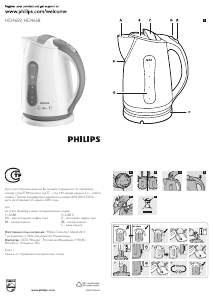

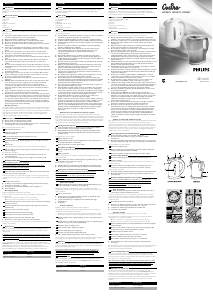
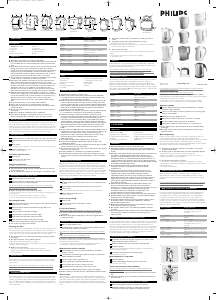
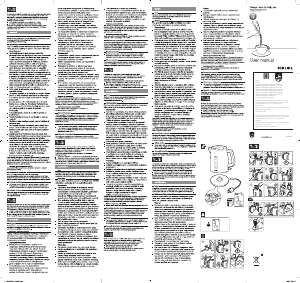
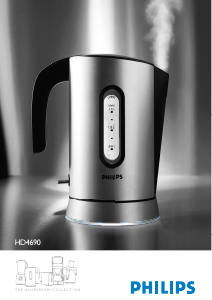
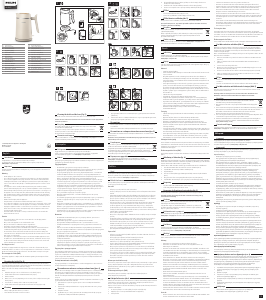
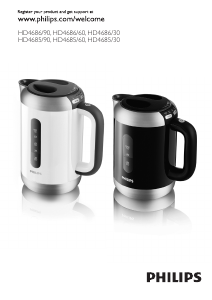
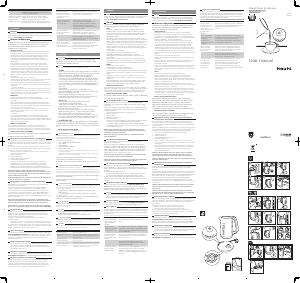
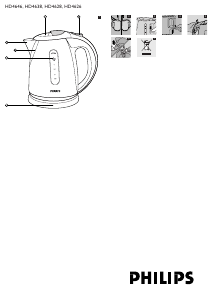
Dołącz do dyskusji na temat tego produktu
Tutaj możesz podzielić się swoją opinią na temat Philips HD4658 Czajnik. Jeśli masz pytanie, najpierw dokładnie przeczytaj instrukcję. Zapytanie o instrukcję można złożyć za pomocą naszego formularza kontaktowego.